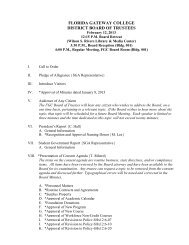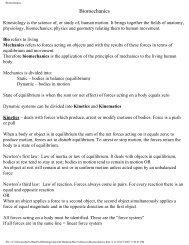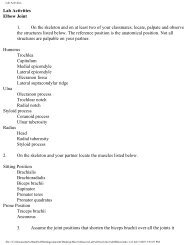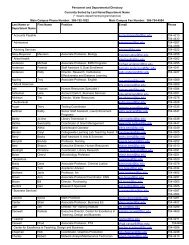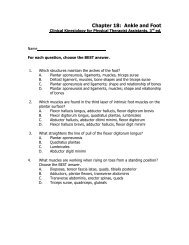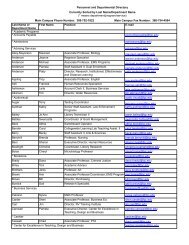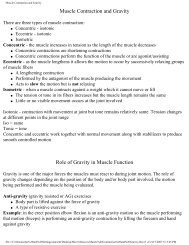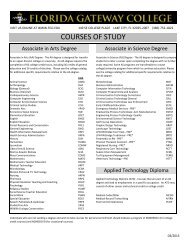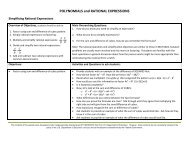Create successful ePaper yourself
Turn your PDF publications into a flip-book with our unique Google optimized e-Paper software.
<strong>PALPATION</strong> <strong>OF</strong> <strong>MUSCLES</strong><br />
See Hoppenfeld for more information<br />
Trapezius: superficial, can palpate upper, middle and lower<br />
Upper is frequently involved in neck injuries<br />
Hold the sloping superior lateral portion between fingers and thumb and palpate from<br />
origin (O) toward the clavicle/acromion and its insertion (I)<br />
With patient (pt.) standing: abduct shoulders to 90 degrees and retract shoulder girdle.<br />
Slightly bend the trunk forward so antigravity.<br />
Upper can also be seen with elevation and lower with depression<br />
Serratus Anterior: superficial at (O), middle and upper covered by pectoralis under<br />
axilla<br />
Standing: flex shoulder to 90 degrees, flex elbow fully. Have pt. force arm fwd as if<br />
trying to touch wall. Avoid trunk rotation.<br />
Rhomboids: Palpated together. Covered by trapezius so need to relax trap by placing<br />
hand in small of back. Palpate along vertebral border by placing fingers under it. Have pt.<br />
lift hand off back (with resistance if needed) and the rhomboids push fingers out. AKA<br />
"typing muscle".<br />
Deltoid: superficial from (O) to (I). Lateral 1/3 of clavicle, across the AC jt., follows<br />
anterior/lateral and posterior borders of acromion and sweeps down the spine of scapula.<br />
Flex elbow to 90 degrees and have pt. abd shoulder against resistance.<br />
Anterior fibers: deltoid palpated with elbow extended, shoulder 90 degrees abd and then<br />
resist horizontal add.<br />
Posterior fibers: position same as above and then resist horizontal abd.<br />
Pectoralis Major: Abduct the shoulder to palpate easier. The anterior wall of the axilla<br />
is this muscle. The posterior wall is the latissimus dorsi. This ms. is the most frequently<br />
absent congenitally. It has a wide (O) and narrow tapered (I) that covers from the middle<br />
clavicle and whole sternum.<br />
Whole ms. does horizontal adduction and can be palpated when you press palms together<br />
in front of your chest.<br />
Upper portion palpated by raising arm 1/2 way between flexion and abduction to over<br />
100 degrees; then adduct obliquely toward head.<br />
Lower portion palpated with upper extremity in only 30-40 degrees of flex/abd while<br />
adducting<br />
Latissimus Dorsi: With arm abducted can palpate from under axilla toward iliac crests as<br />
far as possible. Have pt. place extended arm on your shoulder and push downward.<br />
Palpate lateral and inferior to axilla<br />
Teres Major: Belly can be palpated but tendon cannot. Place fingers lateral to the<br />
inferior angle of the scapula with shoulder adducted and extended. Flex elbow 90 degrees<br />
and resist extension and adduction
Biceps Brachii: Close fist and supinate, then place forearm under a table surface and<br />
pull up into elbow flexion. Can palpate tendon close to (I) at elbow and then follow it<br />
upward to the ms. belly. You can palpate the tendon in the bicipital groove easier if the<br />
shoulder is externally rotated. With the ms. relaxed, it can be lifted upward away from the<br />
surrounding muscles.<br />
Triceps: Lean on a table supporting your weight as you would during crutch walking<br />
OR resist elbow extension.<br />
Long head felt proximal as emerges from under posterior deltoid. Abduct shoulder 90 +<br />
degrees and resist elbow extension. Can follow 1/2 way down arm<br />
Lateral head is the strongest of the three and can be palpated distal to the posterior<br />
deltoid<br />
Medial head is covered partly by the long head but the distal part can be palpated near<br />
the medial epicondyle<br />
LOWER EXTREMITIES<br />
Psoas Major: Deep ms. and difficult to palpate. Suggest you find psoas on self before<br />
trying others. Have pt. sit and lean trunk fwd to relax abdominal muscles. Place fingers at<br />
the waist between the lower ribs and crest of ilium. With gentle pressure sink fingers in<br />
as deeply as possible toward the posterior wall of the abdominal cavity near vertebral<br />
column. Next, have the pt. flex the hip slightly and you will feel the belly of the psoas<br />
against your fingers as it contracts. NOTE: best done with bowels fairly empty and<br />
should not cause pain.<br />
Tensor Fascia Latae<br />
Sartorius<br />
Rectus Femoris: palpated near hip on anterior surface in supine. Externally rotate hip<br />
and then resist flexion. At the hip there is a "V" formed by the contraction of the TFL<br />
laterally and the sartorius medially. The "V" points toward the foot. In the space<br />
between is the rectus femoris<br />
Gluteus Maximus: palpate standing or prone. Externally rotate and extend hip with knee<br />
flexed. Can also "set" ms. by squeezing the buttocks together<br />
Gluteus Medius: palpated sidelying on opposite side or standing.<br />
Middle portion palpated below the crest of the ilium as the pt. abducts the hip or when in<br />
single leg stance.<br />
Anterior portion palpated posterior to the TFL when hip is internally rotated<br />
Posterior portion palpated during external rotation and hip extension but cannot be<br />
isolated<br />
Quads<br />
Rectus Femoris: see TFL for palpation of proximal portion. Ms. belly palpated<br />
superficially down middle of thigh. Quads are wrapped in a common fascial covering and<br />
cannot always be identified individually
Vastus Medialis: forms visible bulge on the medial side of knee with isometric<br />
contraction<br />
Vastus Lateralis: forms visible bulge on the lateral side of knee with isometric<br />
contraction<br />
Vastus Intermedius: under the rectus. Lift rectus and palpate from the medial or lateral<br />
side<br />
Hamstrings<br />
Biceps Femoris: palpate from common origin on ischium to insertion on lateral side.<br />
Have pt. prone and resist knee flexion<br />
Semimembranosus: most prominent tendon in the back of the knee on the medial side.<br />
Have pt. prone or seated and resist knee flexion<br />
Gastrocnemius: the calf muscle that provides shape to the lower leg. Palpate while pt.<br />
raises up on their toes<br />
Tibialis Anterior: tendon crosses ankle jt. Can be palpated (O) to (I). Have pt. dorsiflex<br />
the ankle and invert the foot. Palpate the belly on the lateral side of the tibial shaft.<br />
Palpate distally to insertion at the base of the first metatarsal and first cuneiform. NOTE:<br />
flex great toe to eliminate confusion with its tendon






